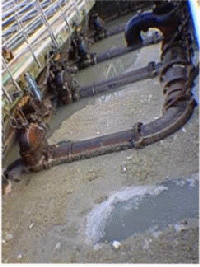 |
 |
 |
 |
| Primary Treatment: Settlement Tank |
Sedondary Treatment: Clarifying Tank |
Tertiary Treatment: Lagoon |
Disinfection: Ultraviolet Light |
First, and this is very important, the federal and state regulations are completely independent of each other. The state government measures the water quality at the beach. The federal government regulates sewage treatment plants. Sewage treatment methods may ultimately affect water quality at beaches, but they are not the same thing.
There are basically four types of sewage. Raw sewage is what goes down your toilet, completely untreated (yuk). Then there are three levels of treatment, primary, secondary and tertiary, depending on what fraction of the solids have been removed. The Federal Clean Water Act of 1972 defined these levels and their application to sewage treatment. Any sewage dumped into a river or other fresh water must be treated at the tertiary level. This treated sewage is supposed to be clean enough to put on your food crops. For ocean dumping, sewage should be treated at the secondary level. However, it takes a long time to upgrade sewage treatment plants and several in the country are not yet compliant with the law. Orange County Sanitation District, as of 1999, was still dumping sewage of which only half was treated at the secondary level and half was treated at the primary level.
Primary Sewage Treatment removes 40% of solids, using filters and a settlement tank. In the tank, oils float to the surface and solids sink to the bottom. The (relatively) less sludgy water is pumped out from the middle.
Secondary Sewage Treatment removes 80% of solids, and uses helpful bacteria to decompose organic materials. The bacteria need oxygen and a place to grow, so the sewage is often churned up and/or filtered through rocks. At the end of this process, the bacteria clump up, and are allowed to settle out of the sewage stream.
Tertiary Sewage Treatment removes not only all the solids, but 95% of the contaminants in sewage. Tertiary treatment uses artificial lagoons and wetlands, where small organisms can clear out particles or use nutrients. The effluent from a tertiary plant can be pumped back into a fresh river or lake, or used to water food crops.
Disinfection kills unwanted bacteria (and probably the helpful ones as well). This can be done using
ultraviolet light, ozone or chlorine. Chlorine disinfection is by far the most common technique, and may
actually be done at any stage of the process. However, tertiary treatment plants are far more likely to
disinfect their sewage.
 |
 |
 |
 |
| Primary Treatment: Settlement Tank |
Sedondary Treatment: Clarifying Tank |
Tertiary Treatment: Lagoon |
Disinfection: Ultraviolet Light |
| Back to Bacterial Measurements | Huntington Beach | Next: Timeline of Events at Huntington Beach |